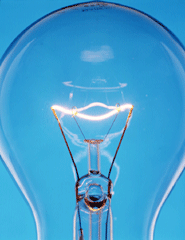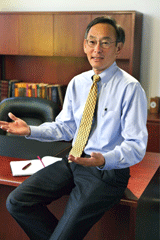Green Light on Energy Standards
Air Date: Week of July 3, 2009

The common light bulb is so inefficient that it generates more heat than light.
Seven percent of all energy consumed in the United States is for lighting. Now, President Obama and Energy Secretary Steven Chu have announced new standards for lightbulbs that will promote energy efficiency and cut carbon dioxide emissions by more than 590 million tons a year. Host Steve Curwood talks with Kateri Callahan, president of The Alliance to Save Energy, about the new standards and how Americans will be able to meet these goals.
Transcript
CURWOOD: According to Energy Secretary Steven Chu, "When it comes to saving money and growing our economy, energy efficiency isn't just low-hanging fruit, it's fruit lying on the ground.”

Energy Secretary Steven Chu. (Courtesy of Lawrence Berkely National Laboratory)
CALLAHAN: Hi Steve, how are you?
CURWOOD: Good. President Obama and his energy secretary Steven Chu have now announced new lighting standards that some are saying this is the U.S.’s greatest push toward saving electricity. How pleased are you with these standards?
CALLAHAN: We’re delighted. This is yet another marker in a march toward a clean energy future that the President announced he was going to take us on and, by golly, he’s doing it. It’s really interesting when you think about little light bulbs, you know, I liken it to the David and Goliath. I mean, they look small, how much energy could you really save? And it turns out that what the President announced yesterday will be the largest energy savings standard that any administration has ever put forward. These standards – once they go into effect in 2012 – within thirty years, we will save enough energy and enough greenhouse gases that are the equivalent of taking 166 million cars off the road, according to the President. So that’s a profound impact on our energy use.
CURWOOD: Now, how much further could they have gone in setting these standards?
CALLAHAN: They could have gone further. There were some studies done – technical studies – they could have moved to more efficient bulbs than they did. But I gotta tell you Steve, this is pretty darn good. The standards apply to two different categories of light bulbs: one are florescent tube lighting that you see commonly in offices and stores. And factories. And the improvement – they’re moving from what they call a T12 tube, which is basically they’re going from and inch and a half round tube down to an inch round tube. Those smaller fluorescents saves about fifteen percent on energy compared to the larger. And the other category is what they call incandescent reflector lamps or IRLs and these are commonly what you see in recessed lighting or some people call it canned lighting and track lighting. And for those there’s gonna be a twenty five percent improvement in the energy efficiency. So, it’s pretty significant.
CURWOOD: Looking over this rule making, this doesn’t go into effect until 2012, that’s what two and a half years from now. What about getting this into place sooner?
CALLAHAN: Well, the light bulbs are available now, Steve, and the issue with standards and having them delayed from the time they’re announced from the time they actually take effect is to allow the manufacturers to scale up production or those who may not be producing the more efficient products to be able to tool up to produce those and also to allow for time for stock to be used for people that have, you know, stock piled some of these things and to get them out of the market system. So it’s very, very typical that there’s a delay in the start of standards so that people can get ready for them.
CURWOOD: So how do you enforce something like this? I mean, I’m wondering if one creates a light bulb police here? I mean, I could use a light bulb police in my house but only for those who snatch the light bulbs – the light doesn’t go on.
CALLAHAN: It won’t be enforced on consumers. No one’s going to come into your house and look at what kind of lights you have. It really is all about getting them out of the marketplace so you don’t have the opportunity to buy them. And so, when you burn out – let me assume for a minute you’ve got some track lighting in your den – when those track lights burn out, if they burn out after 2012, you will no longer be able to choose the most inefficient products that you could today. You’re probably still likely to have choices. There will be more and less efficient bulbs, but they’ll meet a minimum efficiency standard. So that’s the way it’s imposed upon the manufacturers and they’re just simply not allowed to sell the products that don’t meet those standards.
CURWOOD: What about the mercury that’s in compact fluorescent bulbs?
CALLAHAN: Right. Well, there are standards for that that have to be met, and the good news is that the mercury levels in light bulbs that are being produced is actually going down. And it is an issue, but it is one that can be dealt with. The EPA has guidelines about how to properly dispose of CFLs, because they do have some mercury in them, how to clean up after an accident where a CFL breaks. It is an issue. Is it a showstopper? Certainly not. And the interesting thing is that there is more mercury – airborne mercury – that goes into the air from the power plants that are providing electricity to incandescent bulbs – far more – than there is in the CFLs that are using the electricity.
CURWOOD: Kateri Callahan thank you so much.
CALLAHAN: Thank you, Steve.
CURWOOD: Kateri Callahan is President of The Alliance to Save Energy. And for more information on the new light bulb standards, go to our website, loe.org.
[MUSIC: Lal Meri “Give Me Your Light” from Lal Meri (Six Degrees records 2009)]
CURWOOD: Coming up: destroying part of the village in order to save the rest of it – can smart bulldozing make Flint, Michigan better? Keep listening to Living on Earth.
Links
Living on Earth wants to hear from you!
Living on Earth
62 Calef Highway, Suite 212
Lee, NH 03861
Telephone: 617-287-4121
E-mail: comments@loe.org
Newsletter [Click here]
Donate to Living on Earth!
Living on Earth is an independent media program and relies entirely on contributions from listeners and institutions supporting public service. Please donate now to preserve an independent environmental voice.
NewsletterLiving on Earth offers a weekly delivery of the show's rundown to your mailbox. Sign up for our newsletter today!
 Sailors For The Sea: Be the change you want to sea.
Sailors For The Sea: Be the change you want to sea.
 The Grantham Foundation for the Protection of the Environment: Committed to protecting and improving the health of the global environment.
The Grantham Foundation for the Protection of the Environment: Committed to protecting and improving the health of the global environment.
 Contribute to Living on Earth and receive, as our gift to you, an archival print of one of Mark Seth Lender's extraordinary wildlife photographs. Follow the link to see Mark's current collection of photographs.
Contribute to Living on Earth and receive, as our gift to you, an archival print of one of Mark Seth Lender's extraordinary wildlife photographs. Follow the link to see Mark's current collection of photographs.
 Buy a signed copy of Mark Seth Lender's book Smeagull the Seagull & support Living on Earth
Buy a signed copy of Mark Seth Lender's book Smeagull the Seagull & support Living on Earth

